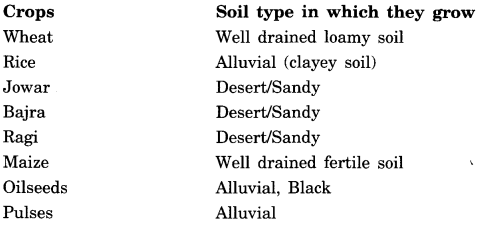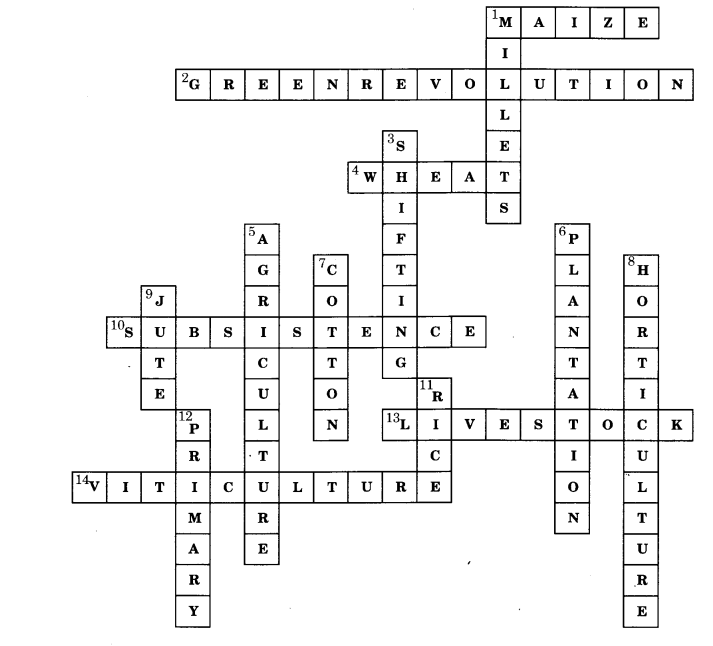NCERT Solutions for Class 8 Social Science Geography Chapter 4 Agriculture
These Solutions are part of NCERT Solutions for Class 8 Social Science. Here we have given. NCERT Solutions for Class 8 Social Science Geography Chapter 4 Agriculture
1. Answer the following questions.
Question 1(1).
What is agriculture?
Answer:
Agriculture is the primary activity which includes the growing of crops, fruits, vegetables, flowers, and the rearing of livestock.
Question 1(2).
Name the factors influencing agriculture?
Answer:
Factors influencing agriculture:
- Favourable Topography
- Soil
- Climate
- Irrigation
Question 1(3).
What is shifting cultivation? What are its disadvantages?
Answer:
In shifting agriculture a plot of land is cleared by felling trees and burning them. The ashes are then mixed with the soil and crops are grown. After the soil loses its fertility, the land is abandoned and the cultivators move to a new plot.
Disadvantages of shifting agriculture
- Soil erosion
- Depletion of forest
Question 1(4).
What is plantation agriculture?
Answer:
- Plantation agriculture is a type of commercial agriculture:
- It is a single crop farming which resembles factory production,
- A large amount of labour and capital is required.
- The produce may be processed on the farm itself or in factories.
- Crops like banana, rubber, tea, coffee, etc. are grown on plantations.
Question 1(5).
Name the fiber crops and name the climatic conditions required for their growth.
Answer:
The two fibre crops are cotton and jute. The conditions required for their cultivation
| Cotton | Jute |
| It requires high temperature. | High temperature required. |
| Light rainfall, 210 frost free days, bright sunshine for its growth. | Heavy rainfall. |
| Grows well in black and alluvial soil. | Grows well in alluvial soils. |
| Area of cultivation: China, USA India, Pakistan, Brazil and Egypt. | Areas of prod: India and Bangladesh. |
Question 2.
Tick the correct answer.
(1) Horticulture means
(a) growing of fruits and vegetables
(b) primitive farming
(c) growing of wheat
(2) Golden fiber refers to
(a) tea
(b) cotton
(c) jute
(3) Leading producers of coffee
(a) Brazil
(b) India
(c) Russia
Question 3(1).
Give reasons.
In India, agriculture is a primary activity.
Answer:
- Because two-thirds of India’s population is still dependent on agriculture.
- The topography, soil, and climate are favourable for the cultivation of various crops.
Question 3(2).
Different crops are grown in different regions because of the following reasons:
Answer:
It happens due to variation in topography, climate, soil types, etc.
Question 4.
Distinguish between the following.
(1) Primary activities and tertiary activities.
(2) Subsistence farming and intensive farming.
Answer:
(1) Distinction between Primary Activities and Tertiary Activities.
|
Primary Activities |
Tertiary Activities |
|
1. Primary activities are those activities in which natural resources are obtained. 2. Examples: Extraction, hunting, mining, gathering, agriculture, fishing, and rearing of livestocks. |
1. Tertiary activities are those activities which provide support to primary and secondary sectors. 2. Examples: Transport, communication, trade, banking, insurance, and advertising. |
(2) Distinction between Subsistence and Intensive Farming.
Intensive farming is a part of subsistence farming. So both have a little difference. Still, some differences are:
Answer:
| Subsistence Fanning | Intensive Farming |
|
1. Subsistence farming is the type of farming practice in which the farmer raises agricultural crops for himself and his family. 2. Household labour is used. 3. Subsistence farming is done on a traditional basis by traditional tools and implements. 4. Production is meant for their own family only. |
1. Intensive farming is an agricultural practice in which efforts are made to increase production with added units of labour and capital and raise two to three crops in a year. 2. Outside labour is hired. 3. Extra tools may be hired. 4. Production is primarily meant for domestic consumption. Excess is sold in the market. |
5. Activity
Question 5 (1).
Collect seeds of wheat, rice, jowar, bajra, ragi, maize, oilseeds, and pulses available in the market. Bring them to the class and find out which type of soil they grow.
Answer:
Collect the seeds of wheat, rice, jowar, bajra, ragi, maize, oilseeds, and pulses available in the market yourself and bring them to the class

Question 5(2).
Find out the differences between the lifestyle of farmers in the USA and India on the basis of pictures collected from magazines, books, newspapers, and the internet.
Answer:
| Criteria | Farm in India | Farm in the USA |
| Average size | 1.5 Hectares. | 250 Hectares. |
| Land tenure | Tenancy, sharecropping fragmentation due to hereditary. | Freehold ownership. |
|
Environment issues |
Use of fertilizers, HYV seeds and irrigation. | Physical factors are less important. |
| Soil | Generally fertile gives two to three crops a year, use traditional knowledge. | Regular soil testing for nutrient deficiency. |
| Crops | Mainly food Crops along with other related activities. Wheat, rice, millets etc. | Specialized farming like com, soya bean, wheat, cotton etc. |
| Operations | Lack of use of scientific technology, machines, more of manual power. | Use of latest technical knowledge and satellite for information. |
|
Economic |
Lack of good transport, communication or even storage facilities, poor farmers. | Better facilities and prosperous farmers. |
| Human factors | Work as farm labour, many dependent on this activity. | Work as a business person, not as a farmer. |
Question 6.
For Fun
Solve the crossword puzzle with the help of given clues.
| Across | Down |
|
1. Crop that needs well-drained fertile soils, moderate temperatures, and lots of sunshine (5) |
1. Coarse grains are also called (7) |
Answer:

We hope the NCERT Solutions for Class 8 Social Science Geography Chapter 4 Agriculture, help you. If you have any query regarding NCERT Solutions for Class 8 Social Science Geography Chapter 4 Agriculture, drop a comment below and we will get back to you at the earliest.